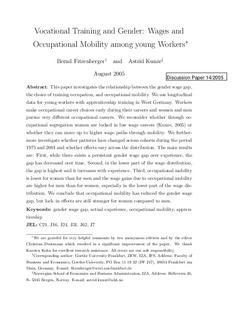Vocational training and gender : wages and occupational mobility among young workers
Working paper
Permanent lenke
http://hdl.handle.net/11250/162704Utgivelsesdato
2005-08Metadata
Vis full innførselSamlinger
- Discussion papers (SAM) [657]
Sammendrag
This paper investigates the relationship between the gender wage gap,
the choice of training occupation, and occupational mobility. We use longitudinal
data for young workers with apprenticeship training in West Germany. Workers
make occupational career choices early during their careers and women and men
pursue very different occupational careers. We reconsider whether through occupational
segregation women are locked in low wage careers (Kunze, 2005) or
whether they can move up to higher wage paths through mobility. We furthermore
investigate whether patterns have changed across cohorts during the period
1975 and 2001 and whether effects vary across the distribution. The main results
are: First, while there exists a persistent gender wage gap over experience, the
gap has decreased over time. Second, in the lower part of the wage distribution,
the gap is highest and it increases with experience. Third, occupational mobility
is lower for women than for men and the wage gains due to occupational mobility
are higher for men than for women, especially in the lower part of the wage distribution.
We conclude that occupational mobility has reduced the gender wage
gap, but lock–in effects are still stronger for women compared to men.
Utgiver
Norwegian School of Economics and Business Administration. Department of EconomicsSerie
Discussion paper2005:14
